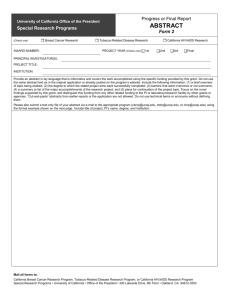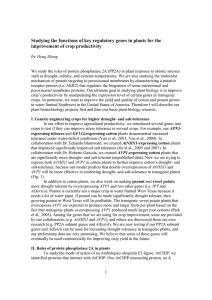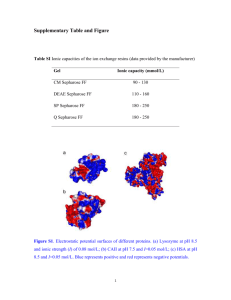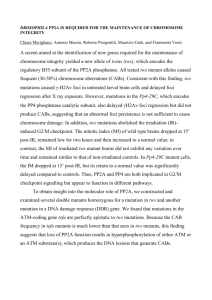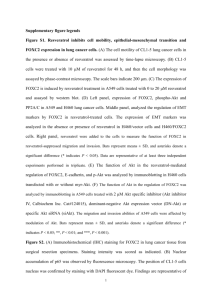AtCHIP functions as an E3 ubiquitin ligase of protein
advertisement
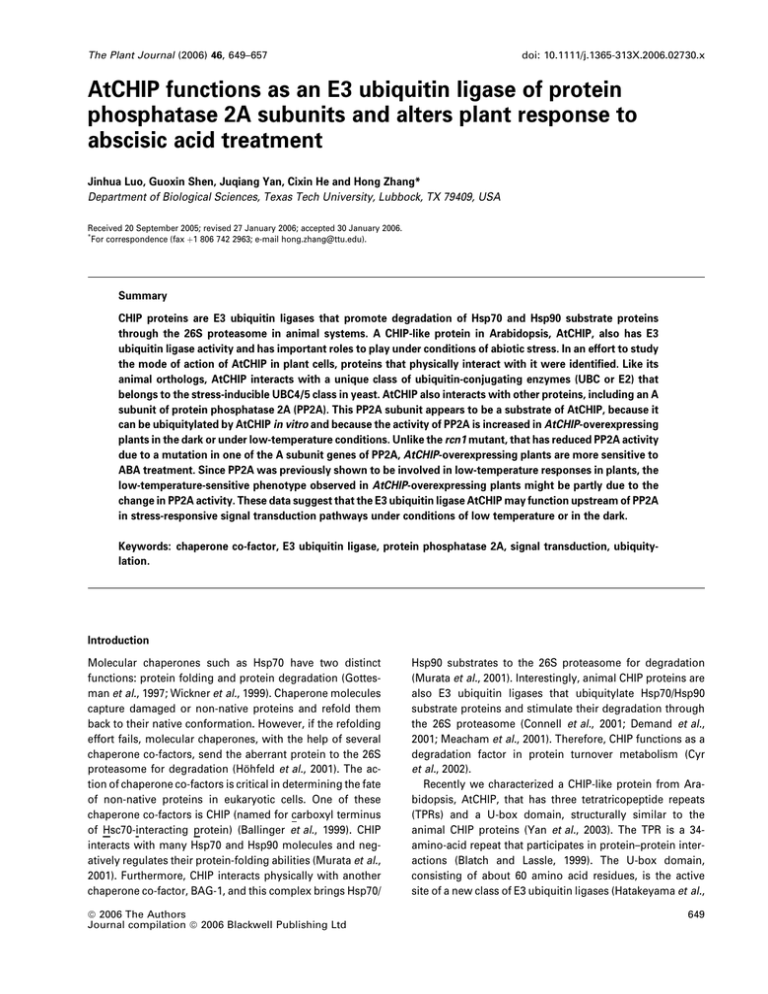
The Plant Journal (2006) 46, 649–657 doi: 10.1111/j.1365-313X.2006.02730.x AtCHIP functions as an E3 ubiquitin ligase of protein phosphatase 2A subunits and alters plant response to abscisic acid treatment Jinhua Luo, Guoxin Shen, Juqiang Yan, Cixin He and Hong Zhang* Department of Biological Sciences, Texas Tech University, Lubbock, TX 79409, USA Received 20 September 2005; revised 27 January 2006; accepted 30 January 2006. * For correspondence (fax þ1 806 742 2963; e-mail hong.zhang@ttu.edu). Summary CHIP proteins are E3 ubiquitin ligases that promote degradation of Hsp70 and Hsp90 substrate proteins through the 26S proteasome in animal systems. A CHIP-like protein in Arabidopsis, AtCHIP, also has E3 ubiquitin ligase activity and has important roles to play under conditions of abiotic stress. In an effort to study the mode of action of AtCHIP in plant cells, proteins that physically interact with it were identified. Like its animal orthologs, AtCHIP interacts with a unique class of ubiquitin-conjugating enzymes (UBC or E2) that belongs to the stress-inducible UBC4/5 class in yeast. AtCHIP also interacts with other proteins, including an A subunit of protein phosphatase 2A (PP2A). This PP2A subunit appears to be a substrate of AtCHIP, because it can be ubiquitylated by AtCHIP in vitro and because the activity of PP2A is increased in AtCHIP-overexpressing plants in the dark or under low-temperature conditions. Unlike the rcn1 mutant, that has reduced PP2A activity due to a mutation in one of the A subunit genes of PP2A, AtCHIP-overexpressing plants are more sensitive to ABA treatment. Since PP2A was previously shown to be involved in low-temperature responses in plants, the low-temperature-sensitive phenotype observed in AtCHIP-overexpressing plants might be partly due to the change in PP2A activity. These data suggest that the E3 ubiquitin ligase AtCHIP may function upstream of PP2A in stress-responsive signal transduction pathways under conditions of low temperature or in the dark. Keywords: chaperone co-factor, E3 ubiquitin ligase, protein phosphatase 2A, signal transduction, ubiquitylation. Introduction Molecular chaperones such as Hsp70 have two distinct functions: protein folding and protein degradation (Gottesman et al., 1997; Wickner et al., 1999). Chaperone molecules capture damaged or non-native proteins and refold them back to their native conformation. However, if the refolding effort fails, molecular chaperones, with the help of several chaperone co-factors, send the aberrant protein to the 26S proteasome for degradation (Höhfeld et al., 2001). The action of chaperone co-factors is critical in determining the fate of non-native proteins in eukaryotic cells. One of these chaperone co-factors is CHIP (named for carboxyl terminus of Hsc70-interacting protein) (Ballinger et al., 1999). CHIP interacts with many Hsp70 and Hsp90 molecules and negatively regulates their protein-folding abilities (Murata et al., 2001). Furthermore, CHIP interacts physically with another chaperone co-factor, BAG-1, and this complex brings Hsp70/ ª 2006 The Authors Journal compilation ª 2006 Blackwell Publishing Ltd Hsp90 substrates to the 26S proteasome for degradation (Murata et al., 2001). Interestingly, animal CHIP proteins are also E3 ubiquitin ligases that ubiquitylate Hsp70/Hsp90 substrate proteins and stimulate their degradation through the 26S proteasome (Connell et al., 2001; Demand et al., 2001; Meacham et al., 2001). Therefore, CHIP functions as a degradation factor in protein turnover metabolism (Cyr et al., 2002). Recently we characterized a CHIP-like protein from Arabidopsis, AtCHIP, that has three tetratricopeptide repeats (TPRs) and a U-box domain, structurally similar to the animal CHIP proteins (Yan et al., 2003). The TPR is a 34amino-acid repeat that participates in protein–protein interactions (Blatch and Lassle, 1999). The U-box domain, consisting of about 60 amino acid residues, is the active site of a new class of E3 ubiquitin ligases (Hatakeyama et al., 649 650 Jinhua Luo et al. 2001; Jiang et al., 2001). AtCHIP is encoded by a single-copy gene in the Arabidopsis genome and it is the only U-box protein found in plants that also contains TPRs (Yan et al., 2003). Like animal CHIP proteins, AtCHIP has E3 ubiquitin ligase activity in vitro. AtCHIP transcripts were upregulated by several stress treatments including low and high temperatures. However, increased AtCHIP expression was not correlated with increased stress tolerance; in fact, overexpression of AtCHIP in Arabidopsis rendered plants more sensitive to both low- and high-temperature conditions (Yan et al., 2003). The growth of AtCHIP-overexpressing plants under chilling temperature conditions was severely retarded, whereas under high-temperature conditions, AtCHIPoverexpressing plants became male sterile. Higher electrolyte leakage was observed in leaves of AtCHIP-overexpressing plants after treatment at chilling temperatures, suggesting that membrane function is probably impaired in these plants under cold conditions. These results indicate that AtCHIP plays an important role in plant cellular metabolism under conditions of temperature stress. To understand the molecular mechanism of AtCHIP’s involvement in the temperature stress response, we identified proteins that physically interact with AtCHIP by using the LexA-based yeast two-hybrid technique (Golemis et al., 1996). One of the AtCHIP-interacting proteins identified is the third isoform of the A subunit of protein phosphatase 2A (PP2A). Protein phosphatase 2A plays important roles in cellular processes including cell cycle and signal transduction (Janssens and Goris, 2001; Millward et al., 1999). Protein phosphatase 2A consists of three subunits: the catalytic subunit C, the variable regulatory subunit B and the structural subunit A. This A subunit serves as a scaffolding molecule that coordinates the assembly of the B and C subunits, generating functionally diverse heterotrimers (Janssens and Goris, 2001; Millward et al., 1999). In Arabidopsis, there are three genes encoding the A subunit: PP2AA1 encodes the A1 isoform (also known as RCN1), PP2AA2 encodes the A2 isoform and PP2AA3 encodes the A3 isoform (Zhou et al., 2004). We found that AtCHIP is able to ubiquitylate PP2AA1 and PP2AA3 in vitro. Furthermore, AtCHIPoverexpression leads to higher PP2A activity under dark or low-temperature conditions when compared with wild-type plants, suggesting that the ubiquitylation of PP2A by AtCHIP increases the activity of PP2A under certain conditions, not leading to the degradation of A subunits of PP2A. A mutation in PP2AA1 (i.e. rcn1) alters auxin transport, enhances ethylene responsiveness and confers ABA insensitivity in Arabidopsis (Garbers et al., 1996; Kwak et al., 2002; Larsen and Cancel, 2003; Rashotte et al., 2001). However, a mutation in either the A2 or the A3 isoform alone does not lead to phenotypes similar to that of the rcn1 mutant. Yet double mutation in the A2 and A3 isoforms results in phenotypes such as severe dwarfing and sterility (Zhou et al., 2004), suggesting that although the three A subunit genes may have partially overlapping functions they each play important roles in plant growth and development. The PP2A activity in plant cells appears to be inhibited under low-temperature conditions, and the inactivation of PP2A by cold was not due to a reduction in transcript or protein level of the PP2A catalytic subunit C, instead it could be due to changes in the interaction of PP2A subunits (Monroy et al., 1998). Evidence indicates that under low-temperature conditions, the binding of anti-PP2Ac (catalytic subunit) antibody to native PP2Ac increased, suggesting a demasking of the PP2Ac epitope which could be caused by removing either the A or the B subunit from the C subunit. Although the molecular mechanism of demasking of the PP2Ac epitope is not known (Monroy et al., 1998), it is clear that PP2A is tightly regulated at low temperatures. Our finding that AtCHIP-overexpression increases PP2A activity in the dark or under low-temperature conditions indicates that AtCHIP may function upstream of PP2A in stress-responsive signal transduction pathways. Results Identification of AtCHIP-interacting proteins To study the mode of action of AtCHIP, we used the LexAbased yeast two-hybrid system to identify the proteins that interact with AtCHIP. We screened an Arabidopsis cDNA prey library and identified proteins that specifically interact with AtCHIP (Figure 1). These candidate proteins fell into two groups: potential substrate proteins of AtCHIP and ubiquitylation-related proteins, i.e. ubiquitin-conjugating enzymes (UBC or E2) and ubiquitins (UBQ). A selection of the identified proteins is shown in Table 1. AtCHIP interacts with Arabidopsis UBC8, UBC9 and UBC10. This was expected because previous studies indicated that animal CHIP proteins interact specifically with the E2 enzymes that Figure 1. Six candidate proteins that specifically interact with AtCHIP. The growth of yeast indicates specific interactions between candidate proteins and AtCHIP bait, whereas no growth indicates no interaction between candidate proteins and other unrelated baits. Lane A, LexA-AtCHIP bait; lane B, no LexA bait; lanes C to F, four unrelated baits (LexA-Bicoid, LexACdc2, LexA-Ftz and LexA-AKR1). ª 2006 The Authors Journal compilation ª 2006 Blackwell Publishing Ltd, The Plant Journal, (2006), 46, 649–657 AtCHIP regulates protein phosphatase 2A activity 651 Table 1 A list of proteins that interact with AtCHIP, but not with any other unrelated proteins Protein Independent clones Total cDNA isolated UBC8 UBC9 UBC10 UBQ1 UBQ5 PP2AA3 FtsH1 ClpP4 RbcS (3b) Lhcb6 6 2 4 2 1 2 2 3 5 1 15 2 10 3 2 2 2 3 21 1 belong to the stress-inducible UBC4/5 family in yeast (Connell et al., 2001; Cyr et al., 2002; Höhfeld et al., 2001), and the Arabidopsis UBC8, UBC9 and UBC10 are classified in the same family as UBC4/5 E2 enzymes of yeast (Bachmair et al., 2001; Girod et al., 1993; Seufert and Jentsch, 1990). There are at least three dozen E2 genes in the Arabidopsis genome (Bachmair et al., 2001), and three of them encode proteins that were found to interact with AtCHIP in the yeast two-hybrid screening. This interaction accounts for about one third of the clones from the screening. Interestingly, AtCHIP also interacts with two ubiquitin proteins, UBQ1 and UBQ5, which are fused to ribosomal proteins L40 and S27, respectively. There are over 15 ubiquitin and ubiquitin-like genes in the Arabidopsis genome (Bachmair et al., 2001); only two were found to encode proteins that interact with AtCHIP. The A subunits of PP2A are substrates of AtCHIP in vitro One of the AtCHIP-interacting proteins is an A subunit of PP2A (PP2AA3; Table 1). To test whether this A subunit of PP2A is a substrate of AtCHIP, we conducted in vitro ubiquitylation reactions using AtCHIP as the E3 ligase and PP2AA3 as the substrate. Western blot analysis was used to determine whether the molecular weight of PP2AA3 is modified by the addition of ubiquitin molecules. Because there were no antibodies against the A subunit of plant PP2A available to us, antibodies against the A subunit of human PP2A were tested first in a Western blot experiment. When purified Arabidopsis proteins, APX3, GF14k and PP2AA3, were assayed by Western blot, only PP2AA3 was recognized by the anti-human PP2A antibodies (Figure 2), establishing that the anti-human PP2A antibodies could be used to detect PP2AA3 and its ubiquitylated products in vitro. As expected, PP2AA3 was ubiquitylated by AtCHIP in vitro (Figure 3a). The anti-human PP2A antibodies recognized one additional band in the Western blot with a molecular weight of 74 kDa. This represents the sum of the molecular weight of PP2AA3 plus the molecular weight of a ubiquitin Figure 2. The antibodies against the human A subunit of PP2A recognize Arabidopsis PP2AA3. (a) Three purified proteins, PP2AA3, GF14k and APX3, were subject to Western blot analysis and only PP2AA3 was recognized by the antibodies (a). (b) A duplicate gel that was directly stained with Coomassie blue after electrophoresis displays where the three proteins migrate in the gel. The molecular weight standards in kDa are marked on the left. (Figure 3a), suggesting that one ubiquitin molecule was added to PP2AA3. In the absence of substrate (i.e. PP2AA3), AtCHIP could carry out the ubiquitylation reaction, creating poly-ubiquitin molecules that could be detected by using anti-ubiquitin antibodies (Figure 3b), as has been shown previously (Yan et al., 2003). In the presence of PP2AA3, poly-ubiquitin molecules could still be detected by using anti-ubiquitin antibodies (Figure 3b). However, using antihuman PP2A antibodies, only one additional band besides the substrate PP2AA3 was detected, indicating that the AtCHIP-mediated ubiquitylation of PP2AA3 is highly specific and that only a single ubiquitin molecule is added to PP2AA3. Since there are three A subunits for PP2A in Arabidopsis (Zhou et al., 2004) and all three A subunits are highly conserved (A2 and A3 share 94% identity, whereas RCN1 and A3 share 86% identity), we thus tested whether AtCHIP might interact with RCN1 as well. Indeed, it interacted very strongly with RCN1 in the yeast two-hybrid assay (data not shown). The ability of AtCHIP to ubiquitylate RCN1 was then tested in the ubiquitylation reaction. It did ubiquitylate RCN1 in vitro (Figure 3c), and again one ubiquitin molecule appeared to be added to RCN1, which was similar to the A3 subunit in the in vitro ubiquitylation reaction (Figure 3a). Because RCN1 and PP2AA3 were both his-tagged, anti-his antibodies were used in the Western blot experiments, and the same results were obtained, i.e. one additional band with ª 2006 The Authors Journal compilation ª 2006 Blackwell Publishing Ltd, The Plant Journal, (2006), 46, 649–657 652 Jinhua Luo et al. Figure 4. Western blot analysis of PP2A A subunits in wild-type and AtCHIPoverexpressing plants. (a) The blot was probed with anti-PP2A antibodies. (b) A duplicate gel used as a loading control was stained with Coomassie blue. WT, wild-type; O264, O3122, O472, and O5182, four independent AtCHIPoverexpressing lines; rbcL, large subunit of ribulose bisphosphate carboxylase/oxygenase. The molecular weight standards in kDa are marked on the left. anti-GF14k antibodies (Figure 3d). This result suggests that GF14k is not a substrate of AtCHIP and this assay also serves as a negative control for AtCHIP-mediated ubiquitylation reactions in vitro. Overexpression of AtCHIP does not affect the steady-state levels of PP2A subunits under normal growth condition Figure 3. In vitro ubiquitylation experiments demonstrate that AtCHIP can ubiquitylate PP2AA3 and RCN1. (a) Substrates used in the in vitro ubiquitylation reactions were PP2AA3 and antibodies used in the Western blot were anti-PP2A antibodies. (b) Substrates were PP2AA3 and antibodies were anti-ubiquitin antibodies. (c) Substrates were RCN1 and antibodies were anti-PP2A antibodies. (d) Substrates were GF14k and antibodies were anti-GF14k antibodies. Because AtCHIP could create poly-ubiquitin molecules in the absence of any substrate (Yan et al., 2003), anti-ubiquitin antibodies recognized numerous bands in the presence or absence of PP2AA3 in the Western blot (b). However, using substrate-specific antibodies, ubiquitylated substrates could be detected in the Western blot, e.g. the mono-ubiquitylated PP2AA3 and the monoubiquitylated RCN1 as indicated by arrows in (a) and (c). The molecular weight standards in kDa are marked on the left. a molecular weight of about 74 kDa was observed (data not shown); therefore we conclude that AtCHIP can ubiquitylate both RCN1 and PP2AA3. Because AtCHIP was initially identified as one of the GF14k-interacting proteins (Yan et al., 2003), it was reasonable to test whether GF14k is also a substrate of AtCHIP. To test this, in vitro ubiquitylation experiments were carried out using AtCHIP as the E3 ligase and GF14k as the potential substrate. Despite several trials, ubiquitylation products could not be detected in Western blot analysis using In animal systems, if only one ubiquitin is added to a substrate by an E3 ligase, this ubiquitylation reaction may not lead to the degradation of the substrate through the 26S proteasome; instead it may lead to an altered cellular destination or enhanced activity of the ubiquitylated substrate (Pickart, 2001; Wojcik, 2001). We tested whether PP2A was affected in AtCHIP-overexpressing plants. Western blot analyses were performed on wild-type and four independent AtCHIP-overexpressing plants that were grown under normal growth conditions, and no substantial differences in the steady-state levels of the A subunits of PP2A were detected (Figure 4). Because it was difficult to separate PP2AA3 and RCN1 in SDS-PAGE (Zhou et al., 2004), we could not determine whether there are subtle changes in the steady-state levels of these two proteins individually based on Western blot analysis, but it appears that the combined amount of PP2AA3 and RCN1 is about the same in AtCHIP-overexpressing plants as in wild-type plants (Figure 4). The four AtCHIP-overexpressing lines have at least four- to fivefold more AtCHIP protein based on previous Western blot analysis (Yan et al., 2003), and the data shown here indicate that overexpression of AtCHIP does not lead to the degradation of the A subunits of PP2A in Arabidopsis. ª 2006 The Authors Journal compilation ª 2006 Blackwell Publishing Ltd, The Plant Journal, (2006), 46, 649–657 AtCHIP regulates protein phosphatase 2A activity 653 PP2A activity is higher in AtCHIP-overexpressing plants than in wild-type plants in the dark or under low-temperature conditions To test whether PP2A activity is affected in AtCHIP-overexpressing lines, we measured the PP2A activity in two control lines and two independent AtCHIP-overexpressing lines. The two control lines were wild-type Arabidopsis and an unrelated transgenic line that contains the Cab3 promoter and GUS fusion construct (i.e. CAB-GUS (Zhang et al., 1994)); the two AtCHIP-overexpressing lines were O472 and O5182, previously described by Yan et al. (2003). Cellular extracts from control and AtCHIP-overexpressing plants under normal growth condition (25C), dark adapted for 24 h, or lowtemperature treated(8C) for 24 h were analyzed for PP2A activity. No significant differences in the PP2A activity were detected between control and AtCHIP-overexpressing plants under normal growth conditions (Figure 5). However, significantly higher PP2A activities were observed in AtCHIPoverexpressing plants after dark or low-temperature treatments when compared with control plants (Figure 5a,b). It appears that AtCHIP-overexpression may override the inhibition of PP2A activity induced by the dark or low-temperature conditions. AtCHIP-overexpressing plants are more sensitive to ABA treatment Because overexpression of AtCHIP increases PP2A activity in the dark or under low-temperature conditions, the characteristics of AtCHIP-overexpressing plants would probably be different from those of rcn1 mutants in their responses to hormone treatments, because the rcn1 mutation leads to decreased PP2A activity (Deruere et al., 1999). The germination rate of AtCHIP-overexpressing plants was analyzed in the presence of ABA. The germination rates of the two AtCHIP-overexpression lines, O472 and O5182, were significantly lower than those of control plants (Figure 6a). The germination of rcn1 mutants, however, was shown to be less sensitive to ABA treatment in comparison with control plants (Kwak et al., 2002). The changes in stomatal aperture of AtCHIP-overexpressing plants in the presence of ABA were determined, and the results indicated that the ABAinduced stomatal closing is increased in AtCHIP-overexpressing plants when compared with control plants (Figure 6b), whereas the ABA-induced stomatal closing is reduced in rcn1 mutants (Kwak et al., 2002). Therefore, it appears that AtCHIP-overexpressing plants demonstrate phenotypes that are opposite to those of rcn1 mutants in the presence of ABA. AtCHIP-overexpressing plants demonstrate an altered response to auxin transport inhibitor Since PP2A is also implicated in the regulation of auxin transport in Arabidopsis (Garbers et al., 1996), the root elongation of control and AtCHIP-overexpressing plants was analyzed in the presence of the auxin transport inhibitor naphthyl-phthalamic acid (NPA). Control plants appeared to be less inhibited by NPA than AtCHIP-overexpressing plants at lower NPA concentrations (i.e. 10 and 50 lM) (Figure 7a). The roots of AtCHIP-overexpressing plants were significantly longer than those of control plants on MS media when kept in the dark (Figure 7b). Again, this response is opposite to the phenotype of rcn1 mutants, which have roots that are 20% shorter than those of control plants (Garbers et al., 1996). These data indicate that overexpression of AtCHIP increases PP2A activity under certain conditions, which, in turn, leads to an altered response to ABA and auxin in transgenic plants. Figure 5. PP2A activities in control and AtCHIP-overexpressing plants under various conditions. (a) Under normal growth conditions and after dark treatment. (b) Under normal growth condition and after cold treatment. WT, wild-type; CAB-GUS, an unrelated transgenic plant; O472 and O5182, two independent AtCHIP-overexpressing lines; Normal, normal growth condition (25C with light); Dark, dark treated for 24 h; PP1, protein phosphatase 1 (as a control); Cold, treated at low temperature (8C) for 24 h. The P-values of the ttest for O472 and O5182 are <1% in both dark and cold conditions. Discussion The E3 ligase AtCHIP adds a single ubiquitin molecule to A subunits of PP2A (Figure 3), indicating the possibility that the ubiquitylation event might not lead to the degradation of the A subunits of PP2A; instead it might lead to a change in their interaction with the B or C subunit or to the enzymatic activity of PP2A. Indeed increased PP2A activities were ª 2006 The Authors Journal compilation ª 2006 Blackwell Publishing Ltd, The Plant Journal, (2006), 46, 649–657 654 Jinhua Luo et al. Figure 6. Germination rates and stomatal apertures of control and AtCHIPoverexpressing plants in the presence of ABA. (a) Germination rates. (b) Stomatal apertures. WT, wild-type; CAB-GUS, an unrelated transgenic plant; O472 and O5182, two independent AtCHIP-overexpressing lines. In (a) the P-values of the t-test for O472 are <5%, <1% and <1% at ABA concentrations of 0.5, 1.0, and 2.0 lM, respectively; the P-values of the t-test for O5182 are all <1% at ABA concentrations of 0.5, 1.0, and 2.0 lM, respectively (n ¼ 1080 plants for each genotype at each data point). In (b) the P-values of the t-test for O472 and O5182 are all <1% at ABA concentrations of 1 and 10 lM, respectively (n ¼ 108 stomata for each genotype at each data point). observed in AtCHIP-overexpressing plants in the dark or under low-temperature conditions (Figure 5), while no obvious difference was seen at steady-state levels of the A subunits of PP2A between wild-type and AtCHIP-overexpressing plants by Western blot analysis (Figure 4). Therefore, it appears that there is a causal relationship between overexpression of AtCHIP and increased activity of PP2A in the dark or under low-temperature conditions. This conclusion is also supported by the observation that phenotypes of AtCHIP-overexpressing plants are opposite to those of rcn1 mutants (Figures 6 and 7). RCN1 is the most important of the Figure 7. Inhibition of root growth by the auxin transport inhibitor NPA (a) and root lengths of wild-type and AtCHIP-overexpressing plants in the dark (b). WT, wild-type; CAB-GUS, an unrelated transgenic plant; O472 and O5182, two independent AtCHIP-overexpressing lines. In (a), the P-values of the t-test for O472 are <5%, <1% and <5% at NPA concentrations of 10, 50, and 100 lM, respectively; the P-values of the t-test for O5182 are <1%, <5% and <1% at NPA concentrations of 10, 50, and 100 lM, respectively (n ¼ 75 plants for each genotype). Inhibition is expressed as the percent reduction in root length relative to that of isogenic seedlings grown in the absence of NPA. In (b) the Pvalues of the t-test for both O472 and O5182 are <1% (n ¼ 90 plants for each genotype). three A subunits (Zhou et al., 2004), and its loss of function due to T-DNA insertion in the rcn1 mutant leads to decreased PP2A activity (Deruere et al., 1999). Since AtCHIP can ubiquitylate RCN1 and PP2AA3, it is reasonable to assume that AtCHIP can also ubiquitylate PP2AA2. Because overexpression of AtCHIP increases PP2A activity in the dark or in lowtemperature conditions, the downstream events of PP2A would probably be affected in AtCHIP-overexpressing plants under certain conditions (e.g. low temperatures or hormone treatments). However, why PP2A activity is not affected in AtCHIP-overexpressing plants under normal growth condition is not clear. Plant PP2A regulates activities of several important enzymes in carbon metabolism, e.g. sucrose synthase (SUS) and phosphoenolpyruvate carboxylase (PPC) (Chollet et al., 1996; Izui et al., 2004; Vidal and Chollet, 1997; ª 2006 The Authors Journal compilation ª 2006 Blackwell Publishing Ltd, The Plant Journal, (2006), 46, 649–657 AtCHIP regulates protein phosphatase 2A activity 655 Weiner et al., 1993). Sucrose synthase plays a critical role in the synthesis and cleavage of sucrose (Huber et al., 1996; Winter et al., 1997), whereas PPC catalyzes the irreversible b-carboxylation of phosphoenolpyruvate to produce oxaloacetate and inorganic phosphate, and it has a major anaplerotic role in replenishing the citric acid cycle with intermediates that are withdrawn for amino acid biosynthesis (Chollet et al., 1996; Vidal and Chollet, 1997). In C4 plants, PPC plays a pivotal role in the primary fixation of atmospheric CO2 (Chollet et al., 1996; Vidal and Chollet, 1997). The activity of PPC is increased by phosphoenolpyruvate carboxykinase (PCK) (Leegood and Walker, 2003), and PP2A can reverse the PCK-mediated activation of PPC (Nimmo, 2003). Both SUS and PPC are more active when phosphorylated, and less active when de-phosphorylated. PP2A is responsible for their downregulation (Chollet et al., 1996; Izui et al., 2004; Vidal and Chollet, 1997; Weiner et al., 1993). Overexpression of AtCHIP leads to increased PP2A activity in vivo, which in turn could decrease the activities of SUS and PPC, leading to slower growth of AtCHIP-overexpressing plants. The literature indicates that PP2A activity in wildtype plants is inhibited under low-temperature conditions (Monroy et al., 1998), which may allow SUS and PPC to maintain certain levels of activity so that plants can still grow, at a slow rate, under chilling temperature conditions. However, when PP2A activity is upregulated due to overexpression of AtCHIP, the SUS and PPC activities would be further reduced by PP2A; thus AtCHIP-overexpressing plants grow more slowly than wild-type plants. A detailed comparative study on the activities of PPC and SUS in AtCHIPoverexpressing and wild-type plants may provide an answer to the question of why wild-type plants grow significantly better than AtCHIP-overexpressing plants under chilling temperature conditions. Because AtCHIP interacts with other proteins in addition to PP2A (Table 1), the cold-sensitive phenotype of AtCHIPoverexpressing plants may not result solely from PP2Amediated cellular processes. Other phenotypes, such as sensitivity to high-intensity light (unpublished data) and high-temperature treatment (Yan et al., 2003), may or may not involve PP2A or its substrates. Slower growth could also result from slower photosynthetic electron transport in AtCHIP-overexpressing plants, which could be due to a reduced function of some chloroplast proteins that participate in electron transport. One such protein, D1, in the PSII reaction center is a substrate of thylakoid membrane-bound protease FtsH1 (Adam and Clarke, 2002), which provides a link to AtCHIP (FtsH1 is another AtCHIP-interacting protein; Table 1). Therefore, the involvement of other AtCHIP-interacting proteins in the cold response is also possible. It is clear that further study of AtCHIP and its interacting proteins will not only provide an insight into the mode of action of AtCHIP in plant cellular metabolism, but will also provide novel information on how PP2A is involved in signal transduction pathways under conditions of low-temperature stress. In particular, using AtCHIP mutants and PP2A mutants (e.g. rcn1) to elucidate the epistatic relationship between AtCHIP and PP2A would significantly improve our understanding of the upstream event of PP2A-mediated signal transduction pathways. Since PP2A participates in many important biological processes in plant cells, our study of the AtCHIP–PP2A interaction reveals how AtCHIP is involved in important cellular metabolic pathways and improves our understanding of the roles that the E3 ligase CHIP and AtCHIP play in eukaryotes. Experimental procedures Isolation of PP2AA3 The coding sequence of AtCHIP was amplified from a cDNA library with the primers AtCHIP-1 and AtCHIP-2, and then cloned into the bait vector pEG202 (Golemis et al., 1996) by using the restriction enzymes EcoRI and XhoI. The procedure for conducting the yeast two-hybrid screening is described by Golemis et al. (1996). PP2AA3 was identified as one of the AtCHIP-interacting proteins from the screening. The nuclear gene coding for PP2AA3 was previously described by Zhou et al. (2004), and was given the Arabidopsis Genomics Initiative locus name At1g13320. The sequences of AtCHIP-1 and AtCHIP-2 are: AtCHIP-1, ATCGAATTCATGGTTACAGGCGTGGCTT; AtCHIP-2, CATCTCGAGTCAACAACCCATCTTGTAAGC. Expression of PP2AA1 and PP2AA3 in bacterial cells and in vitro ubiquitylation of these two proteins The coding sequences of PP2AA1 and PP2AA3 were amplified from a cDNA library with the primers PP2AA1-1 and PP2AA1-2 (for PP2AA1), and primers PP2AA3-1 and PP2AA3-2 (for PP2AA3), then cloned into the pET-30b vector (Novagen, Madison, WI, USA) with the restriction enzymes BamHI and SacI (PP2AA1) or EcoRI and XhoI (PP2AA3). Recombinant vectors were introduced into the bacterial strain BL21(DE3) for expression. PP2AA1 and PP2AA3 were purified according to the manufacturer’s protocol (Novagen). The in vitro ubiquitylation reaction was conducted as described previously (Yan et al., 2003), except that the reaction mixture included AtUBC8 as the E2 conjugase to replace human E2 and yeast E1 (Calbiochem, La Jolla, CA, USA) as the activase to replace rabbit E1. The anti-PP2A antibodies used in detecting the ubiquitylated PP2AA3 and RCN1 in the in vitro ubiquitylation reactions were raised against residues 7 to 19 of the A subunit of human PP2A (Calbiochem), which is equivalent to residues 5 to 17 of Arabidopsis PP2AA3. The sequence of the 13 amino acid residues involved, DDSLYPIAVLID, is highly conserved in eukaryotes, which allows the antibodies to recognize the A subunits of PP2A from both animal and plant sources (Figures 2 and 3a,c). The anti-ubiquitin antibody used to detect polyubiquitin molecules in the Western blot (Figure 3b) was purchased from Sigma (St Louis, MO, USA). The sequences of oligonucleotides used for bacterial expression are: PP2AA1-1, CTAAGGATCCGATGGCTATGGTAGATGAACCG; PP2AA1-2, CATAGAGCTCTCAGGATTGTGCTGCTGTGG; PP2AA3-1, CTAAGAATTCGATGTCTATGGTTGATGAGCC; PP2AA3-2, CATACTCGAGTTAGCTAGACATCATCACATTGT. ª 2006 The Authors Journal compilation ª 2006 Blackwell Publishing Ltd, The Plant Journal, (2006), 46, 649–657 656 Jinhua Luo et al. Immunoblot analysis Root length measurement Protein extracts were made by grinding 3-week-old Arabidopsis leaves in a mortar in extraction buffer (50 mM NaPO4 pH 7.0, 1 mM EDTA). The crude extracts were centrifuged in a microfuge at 15 000 g for 10 min and the supernatants, containing mainly cytosolic proteins, were added to an equal volume of 2· SDS loading buffer (125 mM Tris-Cl, 2% SDS, 20% glycerol, 200 mM dithiothreitol, 0.01% bromophenol blue, pH 6.8). The protein concentration in the extraction buffer was determined by the Bradford method (Bradford, 1976) using bovine serum albumin as a standard. Fifty micrograms of proteins from wild-type and AtCHIP-overexpressing plants was subjected to electrophoresis in a 12% SDS polyacrylamide gel. The conditions for blotting and color development were the same as described previously (Yan et al., 2003). The anti-PP2A antibodies used were the same as above (Figures 2, 3a,c and 4). Root lengths of wild-type and AtCHIP-overexpressing plants were measured after seedlings were grown for 6 days in a vertical position in the dark at 25C on the surface of MS medium as described previously (Garbers et al., 1999). Each Petri dish was scanned on flatbed scanner, and root lengths were measured using a Scionimage program (Scion, Frederick, MA, USA; http://www.scioncorp.com). Three independent experiments were conducted and 30 plants were analyzed in each experiment. PP2A enzyme assay Protein extracts from normal growth, dark-adapted (25C, 24 h) or cold-adapted (8C, 24 h) 10-day-old seedlings were assayed for protein phosphatase activity using the Protein Ser/Thr Phosphatase Assay System (New England Biolabs, Beverly, MA, USA) as described previously (Zhou et al., 2003). The substrate used in the assay was myelin basic protein (MyBP), and the dephosphorylation was carried out in the presence of a chelator of divalent cations (EDTA) to avoid the effects of protein phosphatases PP2B and PP2C. PP2A was defined as the activity not inhibited by Inhibitor-II (PP1 activity was inhibited specifically by Inhibitor-II). Three independent experiments were conducted. Seed germination on ABA-containing media The germination rates were determined on MS plates that contain 0, 0.5, 1 or 2 lM of ABA. Seeds of the same age were used throughout the experiments. Germination was determined 5 days after the plants were transferred to a growth chamber preceded by exposure to 4C for 5 days as previously described (Kwak et al., 2002). Three independent experiments were conducted and 360 plants were analyzed in each experiment for each data point. Stomatal aperture measurement The stomatal apertures were measured in the focal plane of the outer edges of guard cells in epidermal strips. Six-week-old plants were incubated in white light for 2.5 h in stomatal opening solution (5 mM of KCl, 50 lM of CaCl2 and 10 mM of ethane sulfonic acid/Tris, pH 6.15) as previously described (Kwak et al., 2002). Stomatal apertures were measured 3 h after 1 or 10 lM of ABA was added. Three independent experiments were conducted and 36 stomata were analyzed in each experiment for each data point. Root growth inhibition experiment Plants were grown for 6 days in a vertical position in the dark at 25C on MS medium containing NPA at various concentrations, then root lengths were measured as described previously (Garbers et al., 1996). Inhibition is expressed as the percent reduction in root length relative to that of isogenic seedlings grown in the absence of NPA. Three independent experiments were conducted and 25 seedlings were analyzed in each experiment for each data point. Acknowledgements We thank Drs Randy Allen and Paul Pare for reading the manuscript and anonymous reviewers for excellent suggestions for improving the manuscript. This work was supported by grants from Texas Advanced Technology Program and USDA-Southwestern Consortium on Plant Genetics and Water Resources. References Adam, Z. and Clarke, A.K. (2002) Cutting edge of chloroplast proteolysis. Trends Plant Sci. 17, 451–456. Bachmair, A., Novatchkova, M., Potuschak, T. and Eisenhaber, F. (2001) Ubiquitylation in plants: a post-genomic look at a posttranslational modification. Trends Plant Sci. 6, 463–470. Ballinger, C.A., Connell, P., Wu, Y., Hu, Z., Thompson, L.J., Yin, L.-Y. and Patterson, C. (1999) Identification of CHIP, a novel tetratricopeptide repeat-containing protein that interacts with heat shock proteins and negatively regulates chaperone functions. Mol. Cell. Biol. 19, 4535–4545. Blatch, G.L. and Lassle, M. (1999) The tetratricopeptide repeat: a structural motif mediating protein-protein interaction. Bioessays, 21, 932–939. Bradford, M.M. (1976) A rapid and sensitive method for the quantitation of microgram quantities of protein utilizing the principle of protein-dye binding. Anal. Biochem. 72, 248–254. Chollet, R., Vidal, J. and O’Leary, M.H. (1996) Phosphoenolpyruvate carboxylase: a ubiquitous, highly regulated enzyme in plants. Annu. Rev. Plant Physiol. Plant Mol. Biol. 47, 273– 298. Connell, P., Ballinger, C., Jiang, J., Wu, Y., Thompson, L.J., Hohfeld, J. and Patterson, C. (2001) The co-chaperone CHIP regulates protein triage decisions mediated by heat-shock proteins. Nat. Cell Biol. 3, 93–96. Cyr, D.M., Höhfeld, J. and Patterson, C. (2002) Protein quality control: U-box-containing E3 ubiquitin ligases join the fold. Trends Biochem. Sci. 27, 368–375. Demand, J., Alberti, S., Patterson, C. and Hohfeld, J. (2001) Cooperation of a ubiquitin domain protein and an E3 ubiquitin ligase during chaperone/proteasome coupling. Curr. Biol. 11, 1569–1577. Deruere, J., Jackson, K., Garbers, C., Soll, D. and Delong, A. (1999) The RCN1-encoded A subunit of protein phosphatase 2A increases phosphatase activity in vivo. Plant J. 20, 389–399. Garbers, C., DeLong, A., Deruere, J., Bernasconi, P. and Soll, D. (1996) A mutation in protein phosphatase 2A regulatory subunit A affects auxin transport in Arabidopsis. EMBO J. 15, 2115–2124. Girod, P.A., Carpenter, T.B., van Nocker, S., Sullivan, M.L. and Vierstra, R.D. (1993) Homologs of the essential ubiquitin conjugating enzymes UBC1, 4, and 5 in yeast are encoded by a multigene family in Arabidopsis thaliana. Plant J. 3, 545–552. ª 2006 The Authors Journal compilation ª 2006 Blackwell Publishing Ltd, The Plant Journal, (2006), 46, 649–657 AtCHIP regulates protein phosphatase 2A activity 657 Golemis, E.A., Gyuris, J. and Brent, R. (1996) Analysis of protein interactions. In Current Protocols in Molecular biology (Ausubel, F.M., Brent, R., Kingston, R.E., Moore, D.D., Seidman, J.G., Smith, J.A. and Struhl, K., eds). New York: John Wiley & Sons, pp. 20.1.1–20.1.28. Gottesman, S., Wickner, S. and Maurizi, M.R. (1997) Protein quality control: triage by chaperones and proteases. Genes Dev. 11, 815– 823. Hatakeyama, S., Yada, M., Matsumoto, M., Ishida, N. and Nakayama, K.-I. (2001) U-box proteins as a new family of ubiquitinprotein ligases. J. Biol. Chem. 276, 33111–33120. Höhfeld, J., Cyr, D. and Patterson, C. (2001) From the cradle to the grave: molecular chaperones that may choose between folding and degradation. EMBO Rep. 2, 885–890. Huber, S.C., Huber, J.L., Liao, P.C., Gage, D.A., McMichael, R.W., Jr, Chourey, P.S., Hannah, L. and Koch, K. (1996) Phosphorylation of serine-15 of maize leaf sucrose synthase (occurrence in vivo and possible regulatory significance). Plant Physiol. 112, 793–802. Izui, K., Matsumura, H., Furumoto, T. and Kai, Y. (2004) Phosphoenolpyruvate carboxylase: a new era of structural biology. Annu. Rev. Plant Biol. 55, 69–84. Janssens, V. and Goris, J. (2001) Protein phosphatase 2A: a highly regulated family of serine/threonine phosphatases implicated in cell growth and signalling. Biochem. J. 353, 417–439. Jiang, J., Ballinger, C.A., Wu, Y., Dai, Q., Cyr, D.M., Hohfeld, J. and Patterson, C. (2001) CHIP is a U-box-dependent E3 ubiquitin ligase: identification of Hsc70 as a target for ubiquitylation. J. Biol. Chem. 276, 42938–42944. Kwak, J.M., Moon, J.-H., Murata, Y., Kuchitsu, K., Leonhardt, N., DeLong, A. and Schroeder, J.I. (2002) Disruption of a guard cellexpressed protein phosphatase 2A regulatory subunit, RCN1, confers abscisic acid insensitivity in Arabidopsis. Plant Cell, 14, 2849–2861. Larsen, P.B. and Cancel, J.D. (2003) Enhanced ethylene responsiveness in the Arabidopsis eer1 mutant results from a loss-offunction mutation in the protein phosphatase 2A A regulatory subunit, RCN1. Plant J. 34, 709–718. Meacham, G.C., Patterson, C., Zhang, W., Younger, J.M. and Cyr, D.M. (2001) The Hsc70 co-chaperone CHIP targets immature CFTR for proteasomal degradation. Nat. Cell Biol. 3, 100–105. Millward, T.A., Zolnierowicz, S. and Hemmings, B.A. (1999) Regulation of protein kinase cascades by protein phosphatase 2A. Trends Biochem. Sci. 24, 186–191. Monroy, A.F., Sangwan, V. and Dhindsa, R.S. (1998) Low temperature signal transduction during cold acclimation: protein phosphatase 2A as an early target for cold-inactivation. Plant J. 13, 653–660. Murata, S., Minami, Y., Minami, M., Chiba, T. and Tanaka, K. (2001) CHIP is a chaperone-dependent E3 ligase that ubiquitylates unfolded protein. EMBO Rep. 2, 1133–1138. Pickart, C.M. (2001) Ubiquitin enters the new millennium. Mol. Cell, 8, 499–504. Rashotte, A.M., DeLong, A. and Muday, G.K. (2001) Genetic and chemical reductions in protein phosphatase activity alter auxin transport, gravity response, and lateral root growth. Plant Cell, 13, 1683–1697. Seufert, W. and Jentsch, S. (1990) Ubiquitin-conjugating enzymes UBC4 and UBC5 mediate selective degradation of short-lived and abnormal proteins. EMBO J. 9, 543–550. Vidal, J. and Chollet, R. (1997) Regulatory phosphorylation of C4 PEP carboxylase. Trends Plant Sci. 2, 230–237. Weiner, H., Weiner, H. and Stitt, M. (1993) Sucrose-phosphate synthase phosphatase, a type 2A protein phosphatase, changes its sensitivity towards inhibition by inorganic phosphate in spinach leaves. FEBS Lett. 333, 159–164. Wickner, S., Mauizi, M.R. and Gottesman, S. (1999) Posttranslational quality control: folding, refolding, and degrading proteins. Science, 286, 1888–1893. Winter, H., Huber, J.L. and Huber, S.C. (1997) Membrane association of sucrose synthase: changes during the graviresponse and possible control by protein phosphorylation. FEBS Lett. 420, 151– 155. Wojcik, C. (2001) Ubiquitin – more than just a signal for protein degradation. Trends Cell Biol. 11, 397–399. Yan, J., Wang, J., Huang, J.R., Patterson, C. and Zhang, H. (2003) AtCHIP, a U-box-containing E3 ubiquitin ligase, plays a critical role in temperature stress tolerance in Arabidopsis. Plant Physiol. 132, 861–869. Zhang, H., Wang, J. and Goodman, H.M. (1994) Expression of the Arabidopsis gene Akr coincides with chloroplast development. Plant Physiol. 106, 1261–1267. Zhou, J., Pham, H.T. and Walter, G. (2003) The formation and activity of PP2A holoenzymes do not depend on the isoform of the catalytic subunit. J. Biol. Chem. 278, 8617–8622. Zhou, H.-W., Nussbaumer, C., Chao, Y. and DeLong, A. (2004) Disparate roles for the regulatory A subunit isoforms in Arabidopsis protein phosphatase 2A. Plant Cell, 16, 709–722. ª 2006 The Authors Journal compilation ª 2006 Blackwell Publishing Ltd, The Plant Journal, (2006), 46, 649–657

